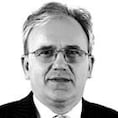The publication of the Junior Cert results for 60,327 students this morning is a stark reminder that the strong growth in the numbers of students progressing through our education system continues.
Within 10 years, we will see 75,000 students taking the revised junior cycle programme, which is being phased in from this month with the introduction of the revised English curriculum to 2019, when the new curriculum will be fully in place.
The key feature of this year’s results continues to be the response of students to the full implementation of the new Project Maths curriculum.
As part of the phased implementation of curricular reform in mathematics, the State Examinations Commission (SEC) provided examinations at higher, ordinary and foundation level to two distinct groups of candidates under Project Maths, with strands one to five of the new programme being examined in the 23 initial schools under phase three, while all other schools were examined in strands one to four, under phase two of the project.
This is the last year in which such separate examinations will apply to these two groups. Next year, the syllabus rollout to all schools will have been completed and candidates in all schools will be examined on the revised syllabus in its entirety.
The proportion of maths candidates who took the subject at higher level increased from 48 per cent in 2012 to 52 per cent in 2013 and has increased further to almost 54 per cent in 2014.
As increasing the uptake of mathematics at higher level is one of the explicit aims of Project Maths, this indication of a greater uptake overall is to be welcomed. Such a change can affect the grade distribution at both higher and ordinary levels. While the total candidature for Junior Cert has increased, the percentage of the total taking the higher-level paper has increased by a much larger amount. This has had the effect of lowering the percentage of A grades obtained.
At ordinary level, the 2014 examination has seen a reduction of 640 in the number of candidates taking the ordinary-level exam. The overall A rate is lower than in previous years, with the ABC and EFNG rates also both lower than in previous years.
A higher percentage of the cohort of candidates has opted for the higher-level paper and therefore some change in the distribution of grades is not necessarily unexpected.
The number of candidates taking the foundation level examination this year is 3,532 – a fall of 369 candidates from 2013. The A rate and ABC rate is lower than in previous years, while the EFNG rate is comparable to previous years.
It would seem that the top end of the traditional cohort for this paper has begun to opt in greater numbers for the ordinary level, which is a welcome development.
The numbers opting to study Irish at higher level continues to rise, increasing this year by 1,304 to 28,664, representing well in excess of half of the 52,601 students who studied Irish at Junior Cert level this year.
Approximately 7,000 of this year’s cohort are exempt from studying Irish due to their arrival into the Irish education system in the past few years or because they have been exempted following the diagnosis of a specific learning difficulty. The introduction of a 40 per cent optional oral component to the overall marks for Irish has had a very positive effect in attracting more students to study the subject at higher level.
It is also interesting to note that an English curriculum which is now being replaced for students starting into first year this September attracted 44,688 to study it at higher level this year as opposed to 13,928 who sat it at ordinary level. It will be interesting to track the reaction of students to the new English curriculum as it is rolled out over the next three years.
French still dominates the continental language choice of students, with 33,908 opting to study it for this year’s exam.
The contrast with the next most popular language, German, which was taken by 10,467 candidates, is stark.
Both Government and industry will be pleased to see that the numbers opting to study science continue to rise each year. Even more encouraging is the fact that the vast majority of students, 42,821 in the current year, are taking it at higher level, with the percentage securing an A grade this year increasing from 8.9 to 11.3.
Finally, given the misgivings of teachers of history and geography over the future of their subject under the new junior cycle curriculum, they will be greatly heartened by the 40,178 and 46,881 students who opted to study their respective subjects at higher level in the current year.











